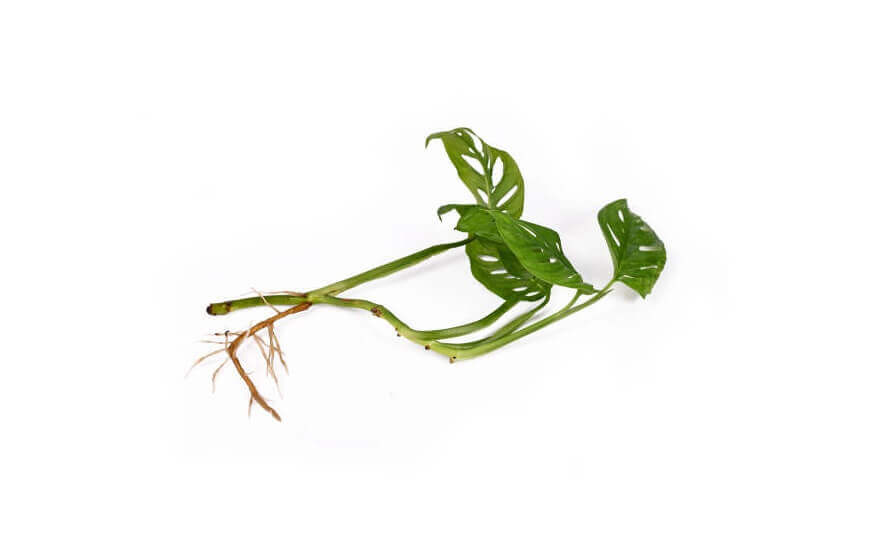, 
Monsteras are known for their large, perforated leaves. The leathery leaves are long and oval in shape, with deep cuts on each side of the midrib forming somewhat oblong holes of various sizes. Along with the fact that they need less care and are easy to maintain, this peculiar leaf feature has led to Monsteras immense popularity as a houseplant. There’s also another feature that adds to the peculiarity of this herbaceous, fast-growing houseplant. The numerous long, brownish, and tough outgrowths from different parts of the plant’s stem. These are known as aerial roots.
Table of Contents
What Are Aerial Roots?
As the name suggests, aerial roots are roots that are air-borne and are typically found in tropical plants. Aerial roots are always adventitious roots – roots that grow from non-root tissues. You might have seen aerial roots growing most prominently in epiphytes like orchids. Epiphytes are defined as a group of plants that grow on another plant or trees and use the aerial roots only for attachment, as they are non-parasitic. Aerial roots are also found in other ecological groups like mangroves and hemiepiphytes.
Monsteras are hemiepiphytes which means they spend at least some part of their life cycle as an epiphyte. They develop aerial roots but also have connections with the ground, forming soil roots. In the initial phase of their growth, aerial roots have a knob-like appearance and are white in color, which over time turn brown with maturity. The aerial roots grow from the many nodes present in the stem, especially around the axis where the leaf petioles – the thin, erect stem of the leaves – meets the main stem. Monstera aerial roots can vary in their thickness from 1.5 mm to 10 mm.
What Are The Functions Of Aerial Roots On Monstera Plants?
Monsteras are native to the Central American tropical forests. They are Aroids or plants belonging to the family Araceae. Aroids are climbing vines and need some form of support or the other to reach higher above the ground. In their natural habitat, Monsteras use tall trees by attaching themselves with their aerial roots, gaining height for better light exposure above the canopy.
In the typical epiphytes, the aerial roots perform few basic functions like absorbing moisture, taking in mineral nutrition, and also performing photosynthesis to some extent. In hemiepiphytes like Monsteras, they are primarily grown to reach the ground from greater heights and then subsequently rooting. But they also serve other additional purposes.
Following are some of the functions of aerial roots on Monstera plants:
-
Absorption Of Atmospheric Moisture:
Native to high humidity regions, Monsteras need moisture in high quantities. Aerial roots are able to provide moisture if needed in case of lack of water, by absorbing from the atmosphere.
-
Structural Support:
Monsteras are unable to stand on their own and need external support to climb. Aerial roots provide the plant, which can reach up to 60 feet in the wild, with the support needed to attach themselves to trees or other structures. Indoors, the aerial roots need to be adjusted around the supporting pole.
-
Help With Air Exchange And Access To Light:
The pores in the aerial roots help the plant with the exchange of air, whenever needed, especially in the case of waterlogged soil. Aerial roots also assist the plant to grow higher and get better access to light.
-
Providing Nutrients And Water:
When the aerial roots grow longer, they reach the soil and convert into normal roots, providing water and nutrients like any underground roots.
What Are The Different Types Of Roots On Monsteras?
In all Monstera grows three different types of roots in their lifetime. These three root types also differ in their anatomical development and in their growth pattern.
Aerial Roots:
As defined earlier, aerial roots are those roots that grow in the air, above ground.
Aerial-subterranean Roots:
These are the roots that started off as aerial roots and after growing long enough to reach the ground, they become subterranean roots.
Lateral-subterranean Roots:
These are the roots that grow laterally on the aerial-subterranean roots. Lateral-subterranean roots are the usual underground roots typically found in most plants.
Differences Between Aerial Roots And Other Roots of Monsteras:
Apart from the difference in origin of these roots on the Monstera plants as described in the definitions above, there are marked differences between the three root types.
- Compared to aerial-subterranean roots and lateral-subterranean roots, the aerial roots on Monstera showed the greatest elongation rate and greatest elongation zone. The rates of elongation and zonation remained almost constant with time on the other two root types.
- The increase in the elongation rate of aerial roots also correlated with the elongation zone that grew larger with time.
- The different growth rate among these root types is attributed to the initiation and maturation of certain cell types and tissues in them. Aerial roots show a peculiar type of growth that is similar to the manner of growth observed in leaves, stems, or fleshy fruits.
- While the period of elongation growth is several times longer in aerial roots, the relative rate of growth in other root types is higher in comparison.
- Monstera subterranean roots are thinner than aerial roots and show a more uniform thickness of about 1 mm to 1.5 mm.
What To Do With The Aerial Roots On Monstera Deliciosa Plants?
Aerial roots on Monsteras are as natural as the perforations in their leaves. It is not an abnormality but a part of the plant’s growth process. If the aerial roots are not a hindrance, to the plant or to the decor of the area where the plant is placed, you can leave them as they are.
Since Monsteras need to be supported as they grow, you can tie the aerial roots while you are attaching the plant stem to the support stick or pole. This also aids in keeping the growth of the aerial roots around the pole, ensuring a neater and more organized appearance of your Monstera plant.
You can also choose to trim them to control their growth. As aerial roots can grow fast and in great numbers, they can become quite excessive to the point of entangling the plant or tipping over the container due to their weight. Trimming them is the easiest solution. Make sure to use a clean, sharp, and properly sanitized pair of scissors to trim the roots. This will help prevent the introduction of any bacterial or fungal disease into the plant.
Pruning is another option that can be done by cutting at the spot where the root meets the stem. It needs reminding that when pruning is performed, it may encourage more growth and even multiple aerial roots growing in the same area.
FAQs About Monstera’s Aerial Roots
What is the difference between aerial roots and soil roots?
The basic difference between the two roots is in the name itself. Aerial roots being air-borne roots and roots that are subterranean, growing underground are referred to as soil roots.
Are aerial roots specific or unique to Monstera?
As explained earlier, many different types of plants showcase the growth of aerial roots for several different purposes. While the presence of aerial roots on Monstera plants does not harm the host plant or trees, in other plant species the relationship can be harmful. Aerial roots of parasitic plants actually take nutrients from their host plant, leading to depletion of nutrition from the host plant. In other plant species, aerial roots can provide a secondary means of propagation, in case a segment of the plant gets cut off.
Is it safe to trim the aerial roots of Monsteras?
Yes, it is perfectly safe as long as trimming is done in a sanitized manner. Trimming of the aerial roots will not harm your Monstera plant. Just be careful to keep some of the aerial roots growing as it helps in the plant’s proper growth.
Can Monstera’s aerial roots be put in the water?
There is no such necessity to keep the long aerial roots in the water as they are meant to perform their functions by being air-borne. Putting the roots in water may do more harm as it can cause the roots to rot. It is ideal to instead spray the aerial roots with water.
Should the aerial roots of Monsteras be left to root in the soil?
As in the case of Monsteras growing in the wild where aerials roots can grow into the soil if the aerial roots touch the soil of the container you can allow them to root. If you do not want the network of aerial roots in the soil, you can easily trim them early when they start growing longer than desired.
Is it possible to grow a new Monstera plant from the aerial roots?
The difference in the anatomical features of the Monstera’s aerial roots prevents them from propagating like the subterranean roots. It is of great advantage if you have a node on a stem with multiple aerial roots, which can then be used for the propagation of the plant through the stem cutting method. To do this the cut needs to be done beneath the node.
How long does it take for aerial roots to grow?
Once a Monstera plant is propagated, it can take only up to about two-three weeks for the aerial roots to start growing on your plant. The ideal growth conditions will help in the proper growth and development of the plant along with the aerial roots.
Can Monstera’s aerial roots damage the wall?
Aerial roots on Monsteras are harmless and will not damage the wall or any structure. These roots are unlike other sticky aerial roots and do not have the features to stick or dig into the structures.
References:
Growth of aerial roots, Morphogenesis of Aerial and Subterranean Roots of Monstera deliciosa , Monstera Deliciosa

Ranjan Singh Moirangthem is a media professional based in India, currently working as a freelance copywriter. Growing up in a hill station and now living in a concrete jungle, he finds solace in the green corners of the city, be it parks or his housing society garden. He’s even passionate about plants and gardening and shares his experience by writing in-depth and well-researched articles for our readers.
